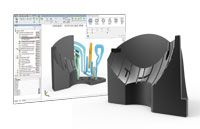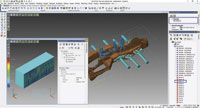by Kip Hanson
To mould and die shops, CAD/CAM is one piece of the software puzzle
The metals used to make plastic injection moulds, progressive stamping dies, and any of the various other production tooling in use today rank among the most difficult to machine. Isn’t it ironic, then, that machining is often the easiest part of this challenging manufacturing sector. Yes, the programmed toolpaths are crazy complex, cutting tool wear is significant on the best of days, extreme tolerances and surface finishes test the mettle of even the most experienced machinists, but it’s all the other “stuff” that accompanies mould and die work that separates the proverbial men from the boys.
The big picture
That stuff includes designing and then producing the electrode sets needed to burn mould cavities. It means determining which mould base or die set to use, along with the correct core pins, ejectors, springs, sliders, lifters and gates. There are inserts to consider and cooling channels to plan. All of this activity needs to be organized, the design approved, the parts procured and the machining and assembly processes monitored. The slightest design mistake or manufacturing slip-up may cost tens of thousands of dollars and delay project fruition by months. Indeed, it’s in the mould and die industry more than any other that shops need an iron grip on every aspect of the manufacturing process.
“Whether they’re producing moulds or doing tool and die work, the most successful companies are those that use an integrated software suite to manage the entire workflow, from the initial feasibility study through to project completion,” says Sridharan Hariharan (Hari), director of application engineering and training for the Americas at 3D Systems Inc. “A robust solution obviously includes highly capable programming and design tools, but should also support quoting, analysis, change order management, simulation and more.”
 Michael Thiessen, regional sales manager at Tebis America Inc., agrees. “Mould and die shops can benefit greatly by looking beyond a generic programming or design package to a complete process solution, one designed specifically for their industry,” he says. “This means anything that’s happening on the production floor can and should be managed within the same software package, whether it’s gun drilling, EDM, CNC milling or turning, as well as whatever supporting processes are needed to deliver a complete tool.”
Michael Thiessen, regional sales manager at Tebis America Inc., agrees. “Mould and die shops can benefit greatly by looking beyond a generic programming or design package to a complete process solution, one designed specifically for their industry,” he says. “This means anything that’s happening on the production floor can and should be managed within the same software package, whether it’s gun drilling, EDM, CNC milling or turning, as well as whatever supporting processes are needed to deliver a complete tool.”
Both companies offer such a solution—3D Systems with its Cimatron suite of products and Tebis with a series of mould and die industry packages branded under the Tebis name—as does Tooling Software Technology LLC, the North American distributor of VISI Mold and Die software from Hexagon. “We’ve also developed our own mould and die-based ERP system, TSTracker,” says technical support manager William Poulos.
Three times better
All-encompassing software capabilities aside, Tebis America’s Thiessen says it’s important for shops to keep an eye on the repeat customer prize: reliability, speed and quality. “It’s these three attributes of mould and die work that bring customers back, and at the same time increase revenue for future company growth.”
But what does that mean? As anyone who makes tooling for a living will tell you, the most obvious definition relates to metal removal; without reliable, efficient, and accurate machining processes, moulds and dies won’t pass customer muster, and mouldmakers won’t be competitive.
This important function obviously falls to the CAM side of the equation, which in the mouldmaking world means software that performs to a higher standard than “production” grade CAM systems, able to trace three-dimensional surfaces exactly as the designer intended while generating extremely smooth surfaces. It’s clear that the machine tool also plays an important role in this, as do the cutting tools, toolholders and workholding, but without the right CAM system, mouldmaking as a whole suffers.
“The biggest gain any mould shop can make is reduction of cycle time, and there are some significant differences from one system to the next in this respect—with high quality mould and die software, cycle time reductions of 30 per cent or more are not unusual,” says Thiessen. “But mould finish and accuracy is equally important, as this impacts downstream operations and finished part quality, as is reliability, since without it you’ll lack confidence that the software won’t inadvertently gouge a surface or even crash a very expensive machine tool.”
Stop the bleeding
Yet reliability, speed and quality are also important attributes of the software itself. “The industry has changed greatly since 2009, when everything fell apart,” says TST’s Poulos. “The apprenticeship programs have largely gone away and getting young people into the trades has become a real challenge. The end result is that much of the die and mouldmaking knowledge has either retired or soon will be, with far fewer skilled people coming in to replace them.”
TST and other software developers have responded by making smarter software. Automation has become a necessary and expected feature in any CAD/CAM system. Poulos says modern mould and die software allows a designer to simply click on a feature or surface and have the software build a complete lifter, for example, or label all
of the ejector pins.
It can also recognize part features such as hole patterns or slots and automatically program them, or analyze a mould cavity and determine the most efficient way to cut it. These capabilities not only mitigate the gradual loss of tribal knowledge, but they also greatly shorten the screen time needed to design a tool or program a machining operation.
 What’s next?
What’s next?
Machine tool technology has also changed greatly over the past decade. Five axis machining centres are increasingly common in mould and die shops, as is additive manufacturing. 3D Systems’ Hari says 3D printed conformal cooling channels are paving the way to shorter cycle times and higher part quality, and without a software package able to manage this and other novel aspects of toolmaking, shops will eventually be left behind.
“Although not every plastic injection mould can benefit from conformal cooling, it is important to analyze the cost savings that can be achieved due to reduced cycle times in high volume production runs,” he says. “In some cases, we have seen up to a 70 per cent reduction in cycle times. Conformal cooling also enables greater design freedom, as use of this technology provides higher part quality by properly cooling critical areas.”
To someone with an admittedly outdated CAD/CAM system, all of this technological wizardry might sound expensive. But as each of the experts in this article will tell you, the return in investment for any high tech software suite is usually quite short. What’s more, a fast, flexible system raises the capabilities of the entire company. But for cash-strapped shops or those not ready to buy the whole enchilada, what are admittedly expensive software suites can typically be purchased in bite-sized pieces as specific manufacturing or management needs arise. Get shopping. SMT
